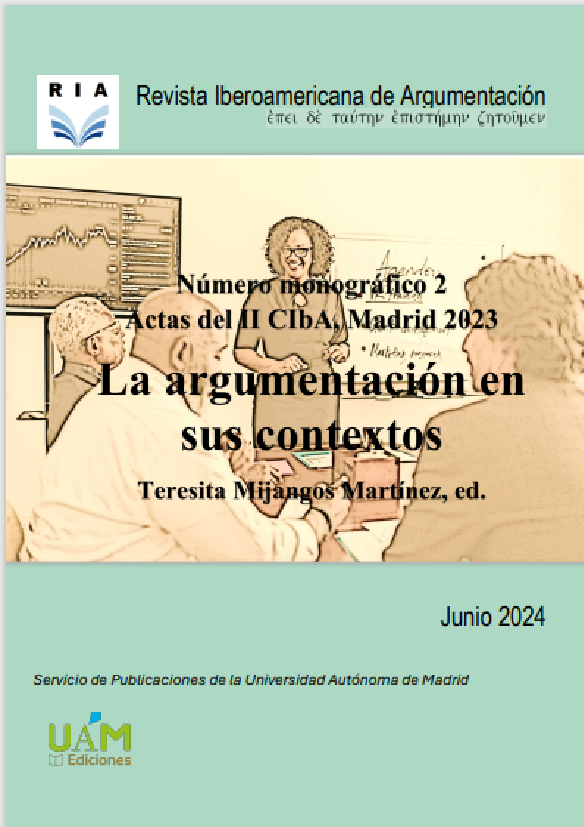Forms of Argumentation in Science. Conjectures and Trials, Abduction and Preduction
Keywords:
abduction, argumentation, conjectures, hypothesis, imagination, preduction, scientific argumentation, scientific method, theoretical explanation, trialsCopyright (c) 2024 Revista Iberoamericana de Argumentación

This work is licensed under a Creative Commons Attribution-NonCommercial-NoDerivatives 4.0 International License.
Abstract
The aim of this article is to present the two main forms of argument that science uses in order to achieve its objectives of innovation and explanation. These are abduction and preduction, which I illustrate with examples from physics. But I also highlight the use of conjectures and trials as a way that shows the strength of imagination in science. In particular, I emphasize the dialogic nature of abduction when it makes possible the substitution or complementation of previous hypotheses, where it takes the form of a macroargument at the service of scientific discovery.
Downloads
References
Bohr, N. (1913). “On the Constitution of Atoms and Molecules”. Phil. Mag. 26, l, 467, 857.
De Broglie, L. (1925). Recherches sur la Théorie des Quanta. Annales de Physique 10e Série, Tome III. Reimpreso en Annales de la Fondation Louis de Broglie, Vol. 17, Nº 1, 1992.
- (1941). Continu et Discontinu en Physique Moderne. Paris: Albin Michel. Versión española, Continuidad y Discontinuidad en Física Moderna. Madrid: Espasa-Calpe 1957.
Dirac, P. (1928). “The Quantum Theory of the Electron”. Proceedings of the Royal Society of London. Series A. Vol. 117. Issue 778, 610-624. Doi: 10.1098/rspa.1928.0023.
Einstein, A. (1905). “Über einen die Erzeugung und Verwendung des Lichtes betreffenden heuristischen Gesichtspunkt”, Annalen der Physik 322, 6, 132-148.
Eisberg, R. y Resnick, R. (1996). Física Cuántica. Átomos, Moléculas, Sólidos, Núcleos y Partículas. México, D.F.: Limusa, Noriega Editores.
Jammer, M. (1989). The Conceptual Development of Quantum Mechanics, 2nd edition, American Institute of Physics.
Kragh, H. (2007). Generaciones Cuánticas. Una historia de la física en el siglo XX. Madrid: Akal.
Landau, L. & Lifshitz, E. (1992). Teoría Clásica de los Campos. Segunda Edición. Barcelona: Editorial Reverté.
Lodge, O. (1897). “The influence of a magnetic field on radiation frequency”. Proc. R. Soc. Lond. 60, 1897, 513–514.
Medawar, P. (1974). “Hypothesis and Imagination”. En Arthur Schilpp (ed.), The Philosophy of Karl Popper, Vol. I, 274-291. La Salle, Ill.: Open Court.
Mehra, J. & Rechenberg, H. (1982). The Historical Development o51f Quantum Theory. Vol. 1, Part 2. New York: Springer Verlag.
Pauli, W. (1925). “On the Connexion between the Completion of Electron Groups in an Atom with the Complex Structure of Spectra”, Zeitschrift für Physik 31. Reimpreso en D. ter Haar, The Old Quantum Theory, New York: Pergamon Press, 1967, 184-203.
- (1946). “Remarks on the History of the Exclusion Principle”, Science, Vol. 103, No. 2669, 213-215.
- (1996). Escritos sobre física y filosofía. Madrid: Debate Pensamiento.
Peirce, Ch. S. (1965). Collected Papers. Cambridge, MA: Harvard University Press.
Planck, M. (1900). “On an Improvement of Wien’s Equation for the Spectrum”, Verhandl. Dtsch. Phys. Ges., 2, 202. Reimpreso en D. ter Haar, The Old Quantum Theory, New York: Pergamon Press, 1967, 79-81.
- (1920). “The Genesis and Present State of Development of the Quantum Theory”. Nobel Lecture. Nobelprize.org. Nobel Media AB 2014. Web. 4 Jun 2017.
- (1949). “Zur Geschichte der Auffindung des physikalischen Wirkungsquantum”. Vorträge und Erinnerungen. Fünfte Auflage, Stuttgart: S. Hirzel Verlag.
Rivadulla, Andrés (2002). “La solución revolucionaria de Planck del problema de la radiación del cuerpo negro”. En Carmen Mataix y Andrés Rivadulla (Eds.), Física Cuántica y Realidad/Quantum Physics and Reality. Philosophica Complutensia. Madrid: Editorial Complutense.
- (2008). “Discovery Practices in Natural Sciences: From Analogy to Preduction”. Revista de Filosofía, Vol. 33, Núm. 1, 117-137.
- (2022). “Tracking Abductive Reasoning in the Natural Sciences”. En Magnani, L. (Eds) Handbook of Abductive Cognition. Springer, Cham. https://doi.org/10.1007/978-3-031-10135-9_75, 1835-1861.
Rovelli, C. (2007). “Quantum Gravity”. In Jeremy Butterfield and John Earman (Eds), Handbook of the Philosophy of Science. Philosophy of Physics. Elsevier.
Shaik, S.; Danovich, D.; Hiberty, P.C. (2021). “Valence Bond Theory – Its Birth, Struggles with Molecular Orbital Theory, Its Present State and Future Prospects”. Molecules 26, 1624.
Sánchez Ron, J. M. (2001). Historia de la Física Cuántica. Barcelona: Crítica, Drakontos.
Smolin, L. (2001). Three Roads to Quantum Gravity. New York: Basic Books.
Sommerfeld, A. (1923). Atomic Structure and Spectral lines. Translated from the third German edition by Henry L. Brose, New York: E. P. Dutton and Company Publishers.
Toulmin, S. (2007). Los usos de la argumentación. Barcelona: Ediciones Península.
Zeeman, Pieter (1897). “The Effect of Magnetisation on the Nature of Light Emitted by a Substance”, Nature 1424, Vol. 55, 347. Translated by Arthur Stanton from the Proceedings of the Physical Society of Berlin.
Wegener, A. L. (1966). The Origin of Continents and Oceans. New York: Dover.
Weinberg, S. (2015). Explicar el Mundo. El descubrimiento de la ciencia moderna. Barcelona: Taurus Pensamiento.
